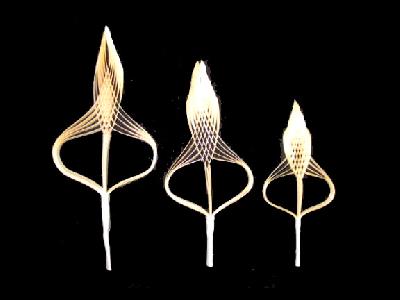神酒口 Mikino-kuchi Mikinokuchi
|
The mikinokuchi is a folk craft article that dates back more than 300 years. It is presented in symmetrical pairs within a tokkuri and placed on the household Shinto altar of each district in order to celebrate the gods. It is also sometimes seen at weddings and ridgepole-raising ceremonies for good luck or as a charm.
Although the origin of the mikinokuchi is unclear, it is believed that it may have developed from a gohei (a white decorative item used mostly in Shinto rituals), or that it is an 'antenna' for receiving a god.
Mikinokuchi are made from bamboo, cypress or paper depending on the district, but mikinokuchi from Shimoichi in Yoshino, Nara Prefecture, are made from Yoshino cedar. Mikinokuchi are made by weaving thin slats of wood that are cut by a kanna and notched on the surface. They are flame shaped, which represents the wish that all evil and filth be burned away.
In Shimoichi, the mikinokuchi is burned after New Year, during the Dontoyaki (a rite which terminates New Year celebrations in Japan) in order to wish for perfect health for everyone throughout the year.
Although the origin of the mikinokuchi is unclear, it is believed that it may have developed from a gohei (a white decorative item used mostly in Shinto rituals), or that it is an 'antenna' for receiving a god.
Mikinokuchi are made from bamboo, cypress or paper depending on the district, but mikinokuchi from Shimoichi in Yoshino, Nara Prefecture, are made from Yoshino cedar. Mikinokuchi are made by weaving thin slats of wood that are cut by a kanna and notched on the surface. They are flame shaped, which represents the wish that all evil and filth be burned away.
In Shimoichi, the mikinokuchi is burned after New Year, during the Dontoyaki (a rite which terminates New Year celebrations in Japan) in order to wish for perfect health for everyone throughout the year.
- address
- Shimoichi-cho, Yoshino-gun, Nara Prefecture
- name
- Mikinokuchi












